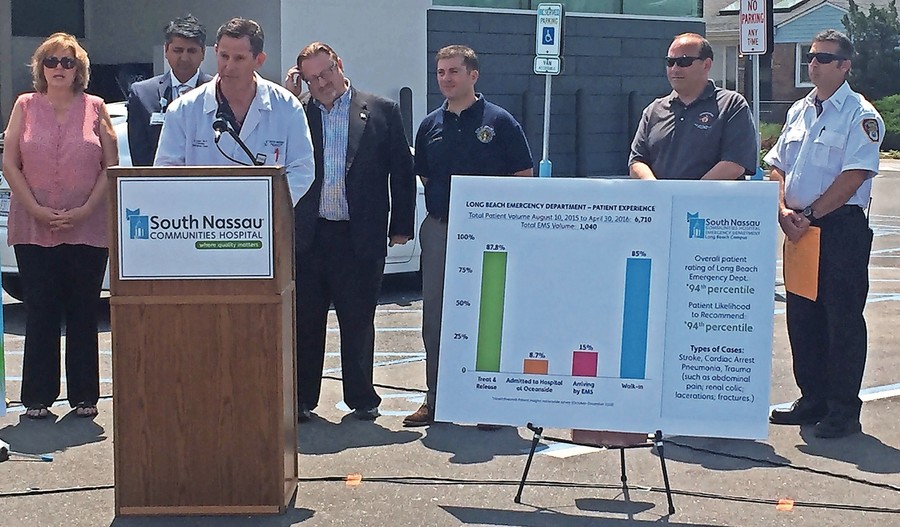Survey says: New Long Beach E.R. a ‘go-to’ facility
South Nassau's emergency department treated 6,710 patients

,Nearly a year after opening a free-standing emergency department in the wake of Long Beach Medical Center’s closure after Hurricane Sandy, South Nassau Communities Hospital last week issued the results of a survey that found that residents are “overwhelmingly” satisfied with the care at the new facility.
South Nassau acquired the medical center in 2014 for $11.8 million following a bankruptcy proceeding, and opened the 24-hour emergency facility last August after receiving state approval.
The new emergency department, at 325 E. Bay Drive, operates as a 911 ambulance-receiving facility and offers around-the-clock emergency medical care. It is meant to serve as a temporary facility as South Nassau moves forward with a plan to build a 25,000-square-foot medical pavilion on the former LBMC campus, expected to open in 2019.
Before it opened, patients were taken to other area hospitals, including South Nassau and Nassau University Medical Center, which many said led to longer turnaround times for ambulances and increased patient volume at SNCH. Residents also demanded the opening of an emergency facility on the barrier island.
According to the survey, conducted by HealthStream, an independent hospital and health care consultant, the new emergency department has treated more than 6,700 patients — suffering from everything from lacerations and broken bones to strep throat and pneumonia to strokes and heart attacks — and nearly 88 percent of them did not have to leave the barrier island. At a press conference on May 26, hospital officials said that patient satisfaction is as high as any emergency departments in the nation, and HealthStream ranked it in the 94th percentile in overall patient rating.
“The data shows that local residents are increasingly depending on South Nassau’s emergency department, have accepted it as the ‘go-to’ facility for emergency care on the barrier island and are having an overwhelming favorable experience,” said South Nassau’s president and chief executive officer, Richard Murphy. “We are encouraged by the success of the facility during its first 10 months of operation and, in fact, are seeing most of the patients that previously were handled by the Long Beach Medical Center’s emergency department before it closed after Sandy.”
The survey was conducted from October to December, and, according to a news release, patients gave high scores to the staff’s bedside care, communication and compassion. Patients who were asked if the “staff is doing everything they could to help with pain” ranked the facility in the 97th percentile nationwide, while the amount of time that doctors spend with patients ranked in the 93rd percentile, and the doctors’ “care about the patient as a person” ranked in the 94th percentile.
Prior to its closure, 90 percent of patients on the barrier island were taken to LBMC, which did not have a trauma unit. Trauma patients were transported to either SNCH or NUMC, while pediatric medical emergencies were taken to South Nassau and burn patients to NUMC. Stroke patients, however, were transported to LBMC, but those patients are now taken to South Nassau. However, if, say, a relative rushes a loved one who has suffered a stroke or other serious injury to the new facility, doctors there can stabilize the patient on site before transferring him or her to another hospital.
Though it does not function as the full-service hospital that many residents have been calling for, patients who are treated and stabilized at the emergency department and who require hospital admission or advanced treatment are transferred by ambulance to South Nassau — a Level II trauma center and an advanced cardiac center — or a hospital of their choice.
Nearly 88 percent of those treated at the facility have been sent home without having to leave the barrier to be treated at another hospital. Some 85 percent of patients arrive at the Long Beach facility on their own, while 15 percent come by ambulance. Of the 6,710 people treated in Long Beach, 8.7 percent were transferred to the hospital in Oceanside.
“We have created a new approach in Long Beach that is really allowing us to spend more time with patients,” said Dr. Joshua Kugler, chair of South Nassau’s Department of Emergency Medicine. “We are becoming a model in Long Beach for how emergency medicine should be delivered.”
But a number of residents, led by the Beach to Bay Central Council of Civic Associations, continue to call on South Nassau to build a full-service hospital on the barrier island, claiming that the emergency department and the planned medical pavilion will not meet residents’ medical needs. Beach to Bay maintains that patients suffering strokes, heart attacks, broken hips, difficult pregnancies and other conditions cannot be taken to the new E.R.
“The only way they can treat heart attacks and strokes is if somebody drives themselves there — the ambulances still can’t go there,” said Barbara Bernardino, co-founder of Beach to Bay. “People are not going there with life-threatening situations — they’re going there as if it’s an urgent care.”
Beach-to-Bay is also calling on South Nassau to invest the bulk of $154 million earmarked for it by the Federal Emergency Management Agency in Long Beach. Currently, South Nassau intends to use about $40 million to build the medical pavilion, and the remaining funds to expand its Oceanside campus.
“Beach-to-Bay and South Nassau are meeting frequently and working together to improve our health care,” the group said in a statement.
Anthony Rifilato contributed to this story.

 80.0°,
Partly Cloudy
80.0°,
Partly Cloudy 



